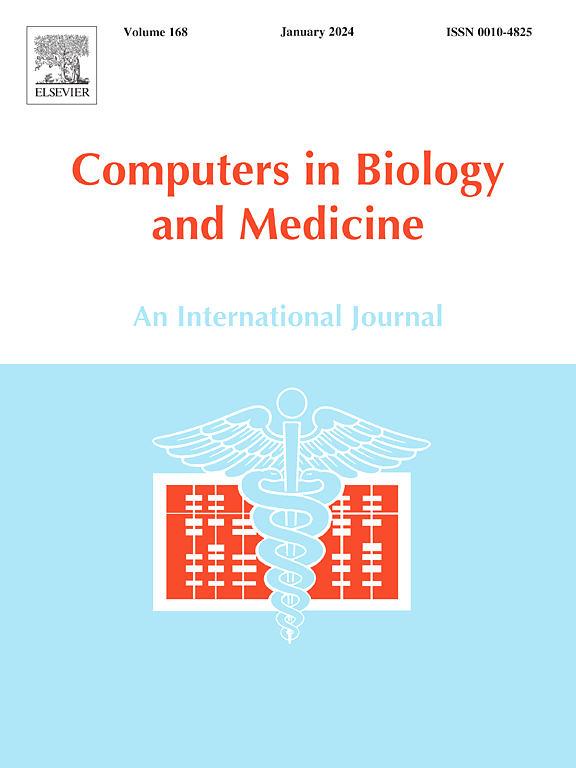Generation of personalized synthetic 3-dimensional inlet velocity profiles for computational fluid dynamics simulations of type B aortic dissection
IF 7
2区 医学
Q1 BIOLOGY
引用次数: 0
Abstract
Background
Computational fluid dynamics (CFD) simulations have shown promise in assessing type B aortic dissection (TBAD) to predict disease progression, and inlet velocity profiles (IVPs) are essential for such simulations. To truly capture patient-specific hemodynamic features, 3D IVPs extracted from 4D-flow magnetic resonance imaging (4D MRI) should be used, but 4D MRI is not commonly available.
Method
A new workflow was devised to generate personalized synthetic 3D IVPs that can replace 4D MRI-derived IVPs in CFD simulations. Based on 3D IVPs extracted from 4D MRI of 33 TBAD patients, statistical shape modelling and principal component analysis were performed to generate 270 synthetic 3D IVPs accounting for specific flow features. The synthetic 3D IVPs were then scaled and fine-tuned to match patient-specific stroke volume and systole-to-diastole ratio. The performance of personalized synthetic IVPs in CFD simulations was evaluated against patient-specific IVPs and compared with parabolic and flat IVPs.
Results
Our results showed that the synthetic 3D IVP was sufficient for faithful reproduction of hemodynamics throughout the aorta. In the ascending aorta (AAo), where non-patient-specific IVPs failed to replicate in vivo flow features in previous studies, the personalized synthetic IVP was able to match not only the flow pattern but also time-averaged wall shear stress (TAWSS), with a mean TAWSS difference of 5.9 %, which was up to 36.5 % by idealized IVPs. Additionally, the predicted retrograde flow index in both the AAo (8.36 %) and descending aorta (8.17 %) matched closely the results obtained with the 4D MRI-derived IVP (7.36 % and 6.55 %). The maximum false lumen pressure difference was reduced to 11.6 % from 68.8 % by the parabolic IVP and 72.6 % by the flat IVP.
Conclusion
This study demonstrates the superiority of personalized synthetic 3D IVPs over commonly adopted parabolic or flat IVPs and offers a viable alternative to 4D MRI-derived IVP for CFD simulations of TBAD.
用于B型主动脉夹层计算流体动力学模拟的个性化合成三维入口速度曲线的生成
计算流体动力学(CFD)模拟在评估B型主动脉夹层(TBAD)以预测疾病进展方面显示出前景,而入口速度分布(IVPs)对于此类模拟至关重要。为了真正捕捉患者特定的血流动力学特征,应该使用从4D血流磁共振成像(4D MRI)中提取的3D ivp,但4D MRI并不常见。方法设计了一种新的工作流程来生成个性化的合成3D ivp,可以取代CFD模拟中的4D mri衍生ivp。基于33例TBAD患者4D MRI提取的3D IVPs,进行统计形状建模和主成分分析,生成270个符合特定血流特征的合成3D IVPs。然后对合成的3D IVPs进行缩放和微调,以匹配患者特定的卒中容量和收缩舒张比。在CFD模拟中,将个性化合成IVPs的性能与患者特异性IVPs进行了评估,并与抛物线型和扁平型IVPs进行了比较。结果合成的三维静脉腔静脉造影足以忠实再现整个主动脉的血流动力学。在升主动脉(AAo)中,在以往的研究中,非患者特异性IVP无法复制体内血流特征,而个性化合成IVP不仅能够匹配血流模式,还能够匹配时间平均壁剪切应力(TAWSS),平均TAWSS差异为5.9%,而理想IVP的TAWSS差异高达36.5%。此外,预测AAo(8.36%)和降主动脉(8.17%)的逆行血流指数与4D mri衍生IVP(7.36%和6.55%)的结果非常吻合。抛物面IVP和平面IVP的最大假腔压差分别从68.8%和72.6%降低到11.6%。本研究证明了个性化合成三维IVP优于通常采用的抛物面或平面IVP,并为TBAD CFD模拟提供了一种可行的替代4D mri衍生IVP的方法。
本文章由计算机程序翻译,如有差异,请以英文原文为准。
求助全文
约1分钟内获得全文
求助全文
来源期刊

Computers in biology and medicine
工程技术-工程:生物医学
CiteScore
11.70
自引率
10.40%
发文量
1086
审稿时长
74 days
期刊介绍:
Computers in Biology and Medicine is an international forum for sharing groundbreaking advancements in the use of computers in bioscience and medicine. This journal serves as a medium for communicating essential research, instruction, ideas, and information regarding the rapidly evolving field of computer applications in these domains. By encouraging the exchange of knowledge, we aim to facilitate progress and innovation in the utilization of computers in biology and medicine.
 求助内容:
求助内容: 应助结果提醒方式:
应助结果提醒方式:


